You exchange cards on Valentine’s Day to express your love, affection, and personal connection with someone special. This tradition dates back centuries, evolving from handwritten notes to beautifully designed cards featuring symbols like hearts and roses. It’s a way to show sincerity and deepen bonds. Modern trends include digital cards and personalized messages, making the act of giving even more meaningful. To discover more about how this heartfelt tradition grew, keep exploring the story behind Valentine’s Day cards.
Key Takeaways
- Exchanging cards symbolizes expressing love, affection, and emotional connection beyond words.
- It traces back to ancient customs of sharing handwritten messages of devotion.
- Cards feature symbols like hearts and roses to visually convey romantic feelings.
- The tradition evolved with technological advances, making personalized and mass-produced cards widely accessible.
- Sending cards reinforces relationships, trust, and lasting emotional bonds on Valentine’s Day.
The Historical Roots of Valentine’s Day Cards
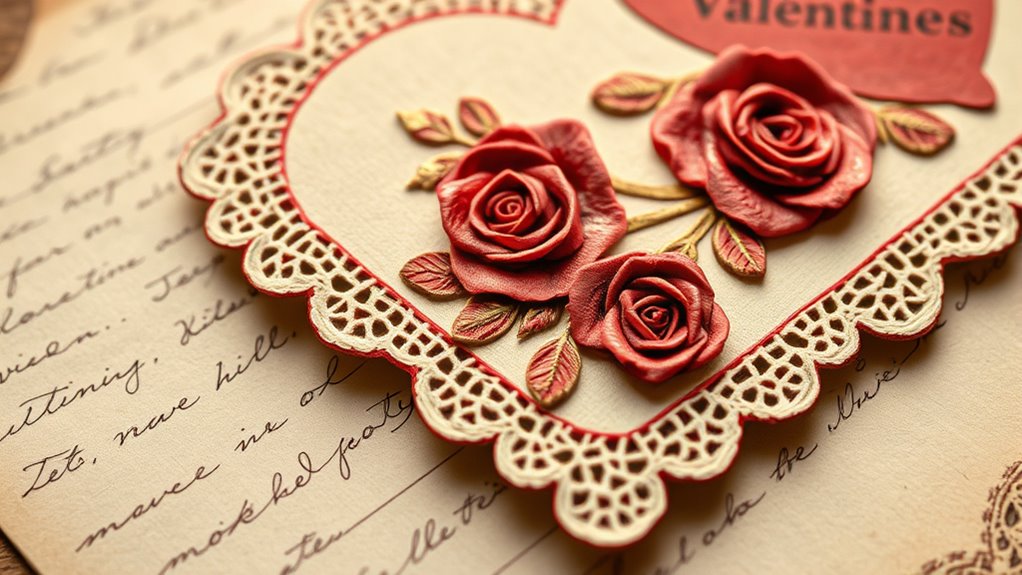
The origins of Valentine’s Day cards can be traced back to ancient times when Romans exchanged handwritten messages to celebrate love and affection. During that period, lovers sent secret notes expressing their feelings, often inscribed on small pieces of parchment or papyrus. These messages served as symbols of devotion and admiration, especially during festivals honoring love. Over time, these simple notes evolved into more formal greetings, with people creatively decorating them to make their feelings more personal. In medieval Europe, the tradition grew as people began exchanging handwritten love notes on February 14th, aligning with the feast day of St. Valentine. These early cards laid the foundation for the elaborate, decorative Valentine’s cards we see today, reflecting centuries of expressing love through heartfelt messages. This evolution was influenced by cultural shifts and the psychological importance of connection, highlighting the enduring human desire to express affection through meaningful gestures.
The Influence of St. Valentine and Early Traditions
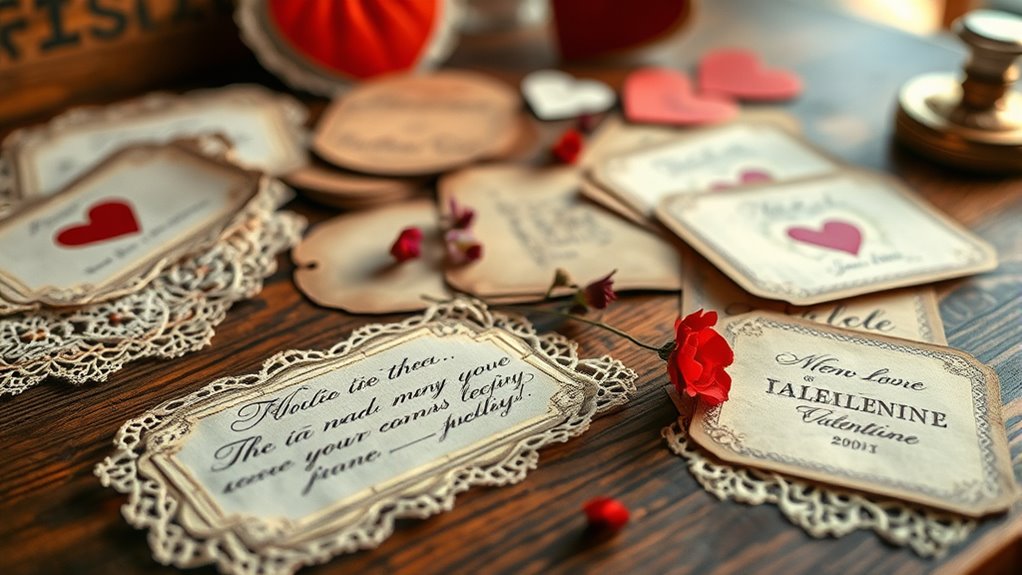
St. Valentine’s story has shaped many of today’s customs, but the true origins are complex. Early traditions often involved exchanging handwritten notes and symbols of love, laying the groundwork for modern cards. Understanding these influences helps you see how symbolism and rituals became central to Valentine’s Day. Additionally, the use of decorative and meaningful symbols in early exchanges contributed to the development of the holiday’s romantic connotations. The historical context also highlights how cybersecurity vulnerabilities and the need for protection have become modern concerns in the digital age of communication. Recognizing the historical evolution of these customs offers a deeper appreciation of the holiday’s enduring significance. Moreover, the transition from handwritten messages to digital communication emphasizes the importance of digital security in preserving personal and sentimental information.
Origins of St. Valentine
Have you ever wondered how the figure of Valentine became associated with love and romance? The story traces back to early Christian martyrs named Valentine. One legend says St. Valentine secretly married couples to help them avoid war, defying Roman laws. Over time, his acts of kindness made him a symbol of love. The following table highlights key facts:
| Fact | Date | Significance |
|---|---|---|
| Feast Day | February 14 | Celebrates St. Valentine’s legacy |
| Martyrdom | Around 270 AD | His sacrifice made him legendary |
| Early Legends | 3rd century | Roots of Valentine’s romantic image |
These stories shape the tradition of honoring love, laying the foundation for Valentine’s Day as we celebrate today.
Early Valentine Customs
Early Valentine customs emerged from the stories and traditions that grew around the legendary figure of Valentine. In medieval times, people believed Valentine was a symbol of love and devotion. During the Middle Ages, lovers exchanged handwritten notes and small tokens to express their affection. In some regions, young men and women would send love letters or tokens anonymously, hoping to keep their feelings secret. By the 15th and 16th centuries, it became common to exchange small gifts, such as flowers or handmade cards, during February 14th celebrations. These early customs laid the groundwork for the modern tradition of exchanging heartfelt messages. Additionally, the values of morality and integrity emphasized in ancient wisdom highlight the importance of sincerity and genuine emotion in these exchanges. The use of handwritten notes also reflected the importance of personal expression and heartfelt communication during that era. Although the practices differed across cultures, the central idea of expressing love and admiration remained constant.
Symbolism of Card Exchange
How did the exchange of Valentine’s Day cards come to symbolize love and devotion? It all traces back to St. Valentine, whose acts of kindness and sacrifice inspired the tradition. Early customs linked these tokens to heartfelt connection and romance, transforming simple messages into symbols of affection. Over time, exchanging cards became a way to express feelings that words alone couldn’t capture. Additionally, the safety features of modern cards help ensure that these exchanges remain meaningful and secure. Consider what these cards represent:
- A heartfelt reminder of your feelings
- The hope of mutual love and understanding
- A gesture of caring and connection
- The celebration of shared vulnerability
- An enduring symbol of devotion across generations
Furthermore, the history of Valentine’s Day reveals how cultural influences and evolving social norms have shaped the tradition of card exchanging, reinforcing its significance in expressing love today. These tokens carry the weight of history and emotion, transforming a simple gesture into a powerful expression of love. Also, advancements in technology have made it easier to share heartfelt messages instantly, emphasizing the importance of meaningful connections in modern celebrations. A deeper understanding of these traditions highlights how the cultural significance of Valentine’s Day continues to evolve worldwide.
The Evolution From Written Messages to Card-Giving
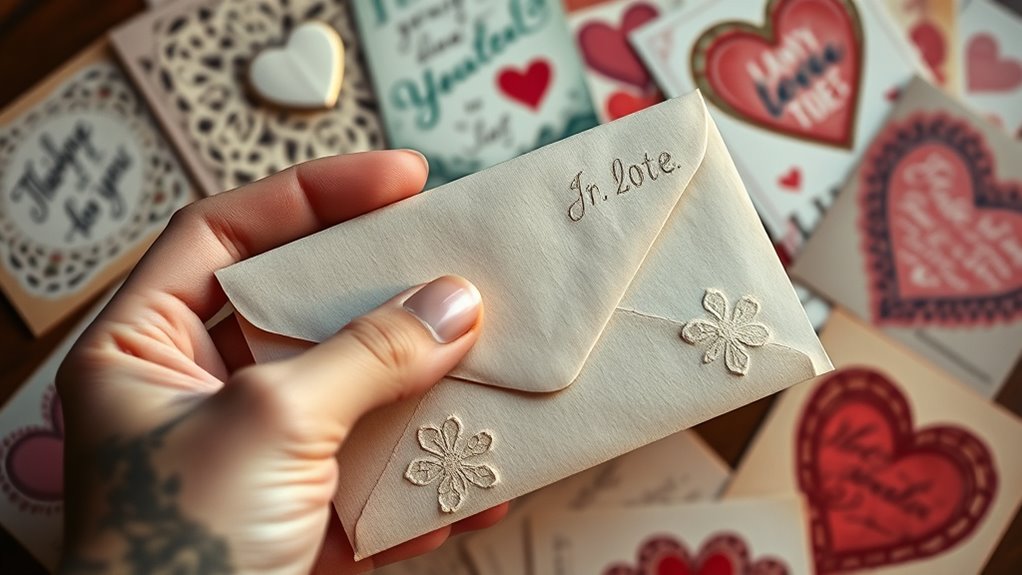
You’ve likely noticed how written messages started as simple letters and grew into more personal gestures. Over time, romantic expressions shifted from words on paper to the exchange of colorful cards. Today, these modern cards continue a tradition that combines history with heartfelt sentiment. This evolution in communication reflects broader societal changes, including the increasing role of automation in business to streamline various processes. Automation in retail has contributed to the efficiency and availability of greeting cards across stores. Additionally, the evolution of communication methods illustrates how cultural practices adapt over time to technological advancements. Transparency in affiliate relationships highlights the importance of understanding the origins and evolving nature of these heartfelt exchanges. The history of greeting card manufacturing demonstrates how technological innovations have expanded this tradition worldwide.
Early Written Correspondence
As written communication became more common, people began exchanging messages to express their feelings and maintain connections. Early handwritten letters allowed individuals to share their emotions across distances, creating a sense of intimacy and anticipation. These messages often carried heartfelt words that conveyed love, longing, and devotion, deepening personal bonds. Over time, letter writing became a cherished tradition, especially on special occasions like Valentine’s Day. The act of crafting a message with care and thoughtfulness reflected the personal touch that remains a valued aspect of heartfelt communication.
Romantic Gestures Evolve
Over time, the simple act of exchanging handwritten letters evolved into a more tangible and personal gift—Valentine’s Day cards. Instead of just words on paper, people began creating decorative, colorful cards that expressed their feelings more vividly. This shift allowed for more creativity and effort, making the gesture feel more special. Cards became a way to visually convey love through drawings, heartfelt messages, or symbols like hearts and roses. As the tradition grew, people started exchanging cards not just for romantic partners but also for friends and family, broadening the gesture’s meaning. The evolution of customized designs further enhanced the personal touch, making each card a unique reflection of the sender’s feelings. Additionally, the use of visual symbols helped communicate emotions that words sometimes cannot fully capture. The popularity of card exchanges has endured over centuries, emphasizing the importance of personal connection and heartfelt expression. The printing technology revolutionized card design, making it easier for people to produce beautiful and intricate cards at home or commercially. Over the centuries, these cards transformed from simple notes into cherished symbols of affection, helping people communicate their emotions in a more expressive and memorable way, especially with innovative printing methods that enable mass production of detailed designs.
Modern Card Traditions
Have modern traditions transformed how we celebrate Valentine’s Day? Today, exchanging cards isn’t just about words; it’s about making moments memorable. Digital messages and e-cards have replaced paper, making it easier to express your feelings instantly. Yet, the essence remains the same: showing love and appreciation. You might:
- Send heartfelt messages that brighten someone’s day
- Choose personalized cards that reflect your unique bond
- Share a surprise card during a busy moment
- Use creative designs to evoke emotion
- Keep the tradition alive, even from afar
- Consider data analytics tracking to craft meaningful messages that resonate deeply
- Recognize the importance of sentiment analysis to understand how your message might be received
These small gestures deepen connections and remind your loved ones they matter. Modern card traditions blend technology with sentiment, creating new ways to celebrate love while honoring the timeless act of giving.
The Role of Romanticism in Popularizing Card Exchange
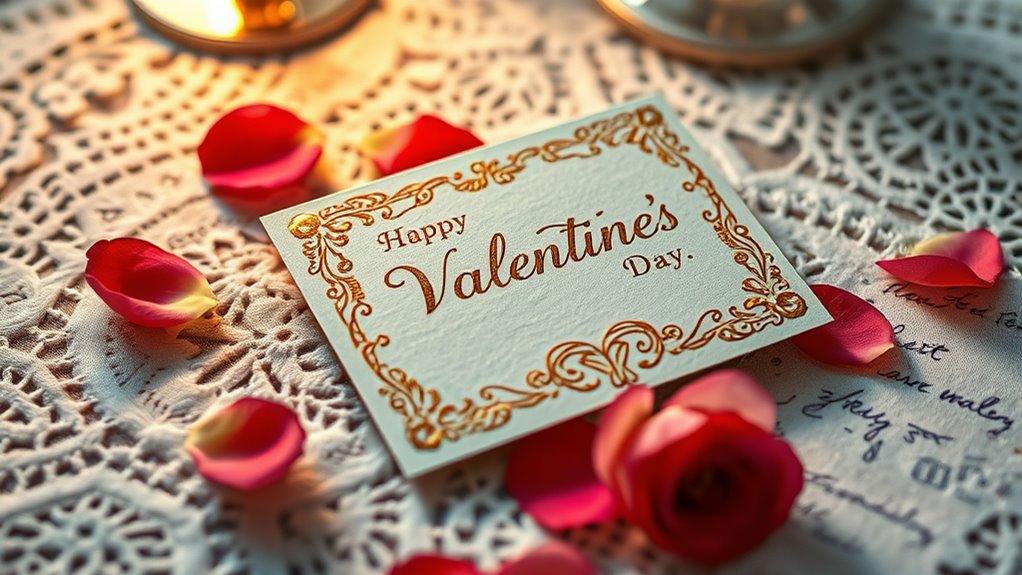
Romanticism played a crucial role in transforming the exchange of Valentine’s Day cards into a meaningful expression of love. During the Romantic era, feelings and individual emotions gained importance, encouraging people to express their affection more openly. Artists and writers emphasized passion, longing, and emotional depth, inspiring lovers to convey their feelings beyond simple gestures. This cultural shift made exchanging cards a powerful symbol of romantic devotion rather than just a social custom. As a result, people began to see Valentine’s Day as an opportunity to celebrate love personally and intimately. The movement’s emphasis on emotion helped elevate the card exchange from a tradition to a heartfelt act of affection, shaping how lovers express themselves even today.
Cultural Variations in Valentine’s Day Card Giving

Cultural differences markedly shape how people celebrate Valentine’s Day and exchange cards. In some countries, like Japan, women give chocolates and cards to men, creating a sense of obligation and anticipation. In South Korea, couples exchange elaborate cards, often accompanied by special meals, emphasizing partnership. In India, the day is gaining popularity but is often more focused on romantic gestures than cards. Meanwhile, in many Middle Eastern countries, public displays of affection are limited, so cards are a subtle way to express feelings.
You might feel inspired by these diverse traditions:
- Heartfelt messages that transcend language barriers
- Unique symbols reflecting local customs
- Surprising acts of kindness tied to card giving
- Celebrations that deepen emotional connections
- The universal desire to express love, no matter the culture
The Symbolism Behind Card Designs and Messages
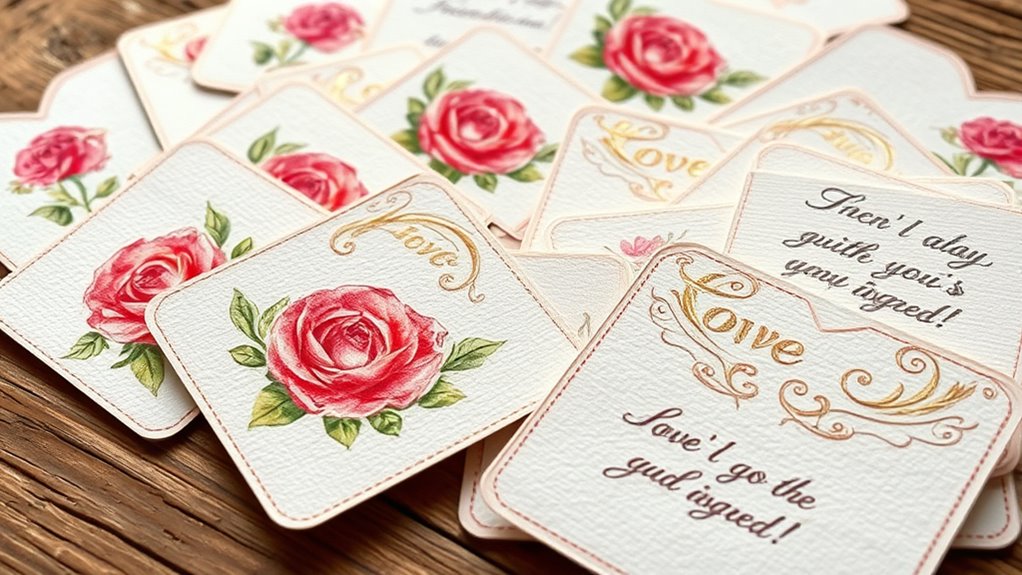
The designs and messages on Valentine’s Day cards are rich with symbolism that reflects both universal themes and specific cultural meanings. When you see hearts, they symbolize love, affection, and emotional connection. Roses often represent passion and admiration, while Cupid’s arrows signify desire and attraction. Words like “love,” “sweetheart,” or “beloved” reinforce feelings of intimacy and devotion. Colors also carry significance; red symbolizes deep love, pink suggests admiration, and white indicates purity. Some cards feature doves or intertwined rings, representing peace and commitment. These symbols serve as a visual language that conveys emotions beyond words, allowing you to express feelings that might be difficult to articulate. The imagery and messages work together to deepen the sentiment behind your heartfelt gesture.
Modern Trends and the Digital Transformation of Valentine’s Cards
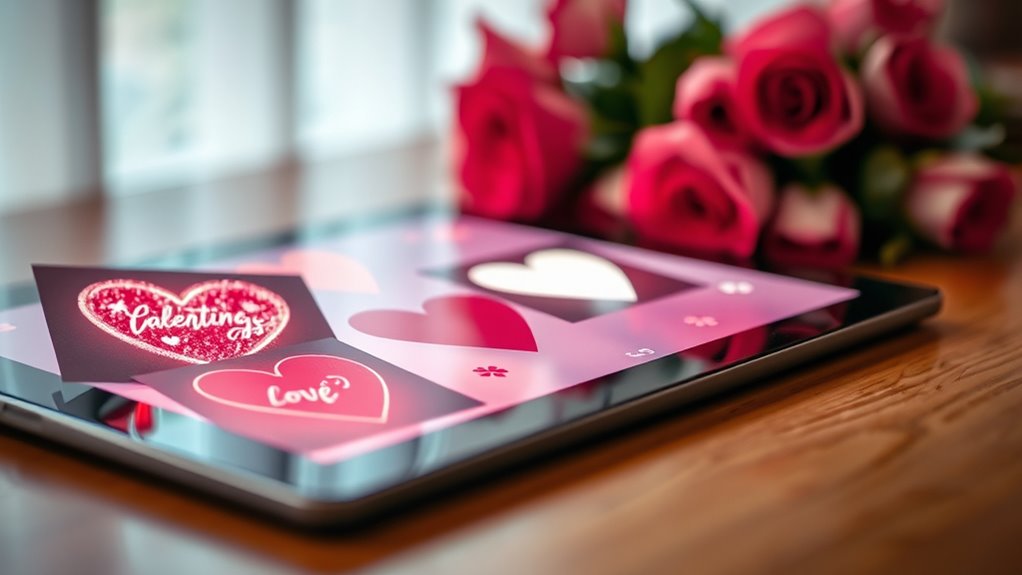
As technology advances, the way people celebrate Valentine’s Day has shifted considerably, leading to the rise of digital cards that offer new ways to express affection. You can now send heartfelt messages instantly, combining visuals, animations, and music to make your feelings stand out. Digital cards make it easy to reach loved ones far away, creating a personal connection despite the distance. They also allow for quick customization, so your message feels uniquely yours. Plus, they’re eco-friendly, reducing paper waste.
Consider these modern trends:
- Sending animated or interactive cards
- Using social media platforms for sharing
- Incorporating personalized videos
- Creating virtual surprise greetings
- Utilizing apps for instant delivery
These innovations deepen your emotional bond and keep the tradition fresh.
Why Sending Cards Continues to Foster Connection
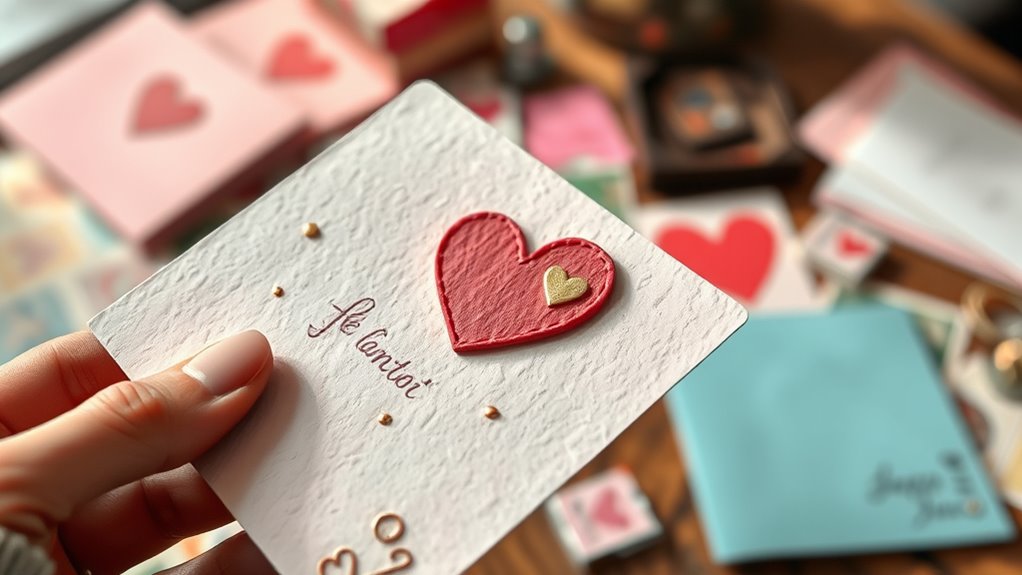
Sending a card, whether digital or physical, creates a tangible reminder that someone cares about you. It shows effort and thoughtfulness that words alone can’t always convey. When you receive a card, you feel seen and appreciated, strengthening your emotional connection. Even in today’s fast-paced world, a heartfelt message can stand out amid digital clutter. It’s a personal gesture that demonstrates you took the time to choose or craft something meaningful. This act of giving fosters trust and deepens bonds, reminding both of you that your relationship matters. Sending cards keeps the tradition alive because it’s a simple, powerful way to communicate love and appreciation beyond spoken words. It’s about creating lasting memories and emotional closeness that endure over time.
Frequently Asked Questions
How Do Valentine’S Day Card Traditions Differ Across Various Cultures?
You’ll notice that Valentine’s Day card traditions vary worldwide. In Western cultures, exchanging heartfelt cards expressing love is common. In Japan, women give cards to men, with men reciprocating later. In South Korea and China, the focus is on romantic and friendship cards, sometimes including elaborate paper crafts. Some cultures see it as a family event, with children exchanging cards at school, highlighting the diverse ways people celebrate love across the globe.
What Psychological Effects Does Exchanging Cards Have on Relationships?
When you exchange Valentine’s Day cards, it boosts your relationship by strengthening emotional bonds. This act makes you feel appreciated and loved, increasing trust and intimacy. Giving and receiving cards also boost your mood and reinforce connection, creating positive feelings that last beyond the holiday. You may feel more valued and understood, which encourages ongoing closeness and open communication, ultimately enhancing your relationship’s emotional health.
Are There Specific Symbols or Messages That Are Universally Understood?
Imagine opening a card that instantly sparks understanding—hearts, roses, or “Be Mine” messages. These symbols are universally recognized, transcending language barriers and cultural differences. They communicate love, affection, and appreciation clearly and quickly. This shared symbolism creates a sense of connection, making your feelings understood without words. Such symbols and messages deepen bonds, reinforcing your emotions and making your message of love both meaningful and easily understood across different backgrounds.
How Has Social Media Impacted Traditional Valentine’S Day Card Exchanges?
Social media has transformed how you celebrate Valentine’s Day, making it easier to send love quickly. Instead of traditional cards, you might share digital messages, photos, or emojis. This shift allows for instant, widespread expressions of affection, but it also risks losing the personal touch of handwritten notes. While social media broadens your options, many still cherish the sentiment behind classic cards, blending new technology with timeless gestures.
What Are Some Unique or Unconventional Valentine’S Day Card Ideas?
Thinking outside the box, you can craft a personalized puzzle card that reveals a sweet message when assembled. Or, try a mini book of reasons why you adore someone, turning simple words into a heartfelt gift. Hand-drawn comic strips or a love coupon booklet also add a playful touch. These unconventional ideas turn the typical card into a memorable keepsake, making your affection feel uniquely special and truly personal.
Conclusion
So, as you exchange Valentine’s Day cards, think of them as tiny bridges connecting hearts across distances. Each message is a whisper of affection, a spark that ignites warmth and understanding. In a world racing by, these tokens remind us that love’s melody still plays softly, resonating through simple gestures. Keep sending those cards—because in doing so, you’re weaving a tapestry of connection that endures beyond words.









